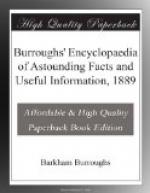The young person who would learn to write a good business letter, should, with pen, ink and suitable paper, sit down and practice faithfully after the above model. Write and re-write it a dozen times or more, until your letter resembles it closely. Then take any of the models for letters given near the close of this chapter, and with this matter, write a letter which will conform with the foregoing model in appearance and dress. Write the same matter over again, and improve it in its defects. Criticise each line and word. See that no words or letters are omitted, and that the punctuation is according to the models in this book. Eliminate all ungainly letters, shorten the loops, see that each letter rests on the line, and that, withal your page is clean and regular.
The person who will thus devote a little earnest study and practice, may early acquire the valuable accomplishment of writing a pleasing business letter, so far as the mechanical structure goes.
ADDRESSING THE ENVELOPE.
After the letter is finished, and while it yet lies open before you, the Envelope should be addressed. As before stated, the directions on the envelope must conform to the address at the beginning of the letter, hence the necessity for addressing the envelope before the letter is folded.
The first line of the address of the envelope should consist of the name of the person or firm to whom the letter is written, together with any appropriate titles, and should be written across or a little below the middle of the envelope, but never above it, beginning near the left edge. The space between this first line and the bottom of the envelope should be about equally divided among the other lines, each of which begins still farther to the right than the one above, thus:
[Illustration:
Messrs. Arnold,
Constable & Co.,
Cor.
Broadway & 19th Sts.,
New
York City.]
When writing to a person in a large city the number and street should be a part of the address, and may be placed as in the above form, or in the left hand lower corner as follows:
[Illustration:
Lewis H. Taylor, Esq.,
Chicago,
118 Wabash Ave. Ill.]
In case the letter is addressed in care of any one this should be placed in the lower left corner. If a letter of introduction, the words Introducing Mr. John Smith, or similar words, should be placed in this corner.
Letters addressed to small towns or villages should bear the name of the county as follows:
[Illustration:
Mr. Henry D. Chambers,
Washington,
Porter
County,
Ala.]
Or the name of the county may be placed in the lower left corner. The Post Office box number is usually placed in the lower left corner.




